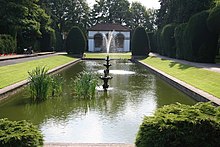| Spalding War Memorial | |
|---|---|
| United Kingdom | |
 | |
| For servicemen from Spalding killed in the First World War | |
| Unveiled | 9 June 1922 |
| Location | 52°47′0.5″N 00°08′57.4″W / 52.783472°N 0.149278°W Ayscoughfee Hall Gardens, Spalding, Lincolnshire |
| Designed by | Sir Edwin Lutyens |
IN LOVE AND HONOUR / OF THOSE WHO / GAVE THEIR LIVES / FOR THEIR COUNTRY / IN / THE YEARS OF WAR / MCMXIV – MCMXIX / THIS MEMORIAL IS RAISED / IN THEIR HOME / BY THE MEN AND WOMEN / OF / SPALDING | |
Listed Building – Grade I | |
| Official name | Spalding War Memorial |
| Designated | 20 November 1975 |
| Reference no. | 1064002 |

Spalding War Memorial is a First World War memorial in the gardens of Ayscoughfee Hall (pronounced /ˈæskəˌfiː/) in Spalding, Lincolnshire, in eastern England. It was designed by the architect Sir Edwin Lutyens. The proposal for a memorial to Spalding's war dead originated in January 1918 with Barbara McLaren, whose husband and the town's Member of Parliament, Francis McLaren, was killed in a flying accident during the war. She engaged Lutyens via a family connection and the architect produced a plan for a grand memorial cloister surrounding a circular pond, in the middle of which would be a cross. The memorial was to be built in the formal gardens of Ayscoughfee Hall, which was owned by the local district council. When McLaren approached the council with her proposal, it generated considerable debate within the community and several alternative schemes were suggested. After a public meeting and a vote in 1919, a reduced-scale version of McLaren's proposal emerged as the preferred option, in conjunction with a clock on the town's corn exchange building.
The total cost of the memorial was £3,500, of which McLaren and her father-in-law contributed £1,000 each; her brother-in-law donated a pair of painted stone flags and the remainder was raised from voluntary subscription, which took until 1922. The memorial consists of a brick pavilion at the south end of the garden and a Stone of Remembrance, both at the head of a long reflecting pool, which incorporates the remains of an 18th-century canal. It was unveiled at a ceremony on 9 June 1922. Lutyens went on to use the style of the pavilion for shelter buildings in several war cemeteries on the Western Front, though none of his other war memorials follow the design and the memorial became relatively obscure. Spalding War Memorial is today a Grade I listed building, having been upgraded when Lutyens's war memorials were declared a "national collection" and all were granted listed building status or had their listing renewed.
